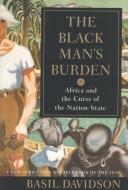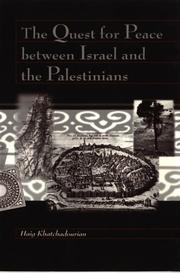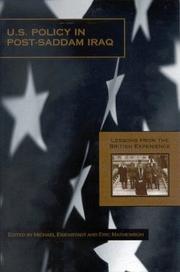| Listing 1 - 10 of 771 | << page >> |
Sort by
|
Book
ISBN: 0567677958 9780567677952 Year: 2018 Publisher: New York: Bloomsbury,
Abstract | Keywords | Export | Availability | Bookmark
 Loading...
Loading...Choose an application
- Reference Manager
- EndNote
- RefWorks (Direct export to RefWorks)
Does John's Apocalypse envision destruction or salvation for the nations of the world? Scholarly views on this issue range from extreme (total destruction) to extreme (universal salvation). Jon Morales maintains that the question must be reframed to highlight, not only the destiny of the nations, but also their dilemma within the drama of world history. Using narrative methodology, Morales asks four key questions concerning the nations: What is John's story of the nations? How does he tell this story? What is John's message to the nations? And what is his message to the church concerning the nations? Literary characters cannot be understood in the abstract, but must be rather discovered sequentially in the development of an entire narrative. The nations in Revelation are no exception. Understanding that previous studies have neglected to situate the nations within Revelation's larger plot, or in interaction with other narrative characters, Morales concludes that John's purpose is to show that the nations belong to God. John achieves his purpose in part by deploying a novel metaphor, virtually unexplored until now – Christ, shepherd of the nations.

ISBN: 081291998X 0812922107 Year: 1992 Publisher: New York (N.Y.) : Times books,
Abstract | Keywords | Export | Availability | Bookmark
 Loading...
Loading...Choose an application
- Reference Manager
- EndNote
- RefWorks (Direct export to RefWorks)
Book
Year: 2010 Publisher: [Place of publication not identified] : Brill,
Abstract | Keywords | Export | Availability | Bookmark
 Loading...
Loading...Choose an application
- Reference Manager
- EndNote
- RefWorks (Direct export to RefWorks)
This new study of the genesis of the Indonesian national state is based on the notion that the birth of that nation grew out of not only the liberation movement but also from the Dutch rule that the nationalists agitated against. The book places a clear emphasis on the ways in which Dutch rule was established in the Indonesian archipelago in the course of three centuries and examines the developments of Dutch colonial policies. This feeds into chapters that focus on the Indonesian nationalist movement and the Japanese occupation of the colony in 1942-1945. The occupation helped to enable the proclamation of Indonesian indepence and the creation of the Republic in August 1945. The conflict that erupted between the Repub-lic and the Netherlands was brought to an incomplete solution in 1949, but the dis-pute about West-Irian led to a sequel that lasted for another thirteen years. More than half of this book is dedicated to the conflict and its aftermath. Much attention is paid to the sentiments and ideas that informed Dutch policy. Various issues that have received scant attention in the historiography are now dis-cussed. The author based his study on Dutch and international literature, contemporary newspapers and policy documents, and his own memories. In the books title, the stork represents the Dutch and the garuda functions as a symbol of Indonesia. J. Herman Burgers (1926) worked at the Dutch Department of Foreign Affairs. He studied Law in Amsterdam and Political Science at Stanford University. He was deeply interested in the conflict between the Netherlands and the Republic of Indone-sia, as it broke out in 1945. This fascination has never left him, and he has continued to study the conflict and its aftermath, especially during the years 1948-1950 when he was in Indonesia for his Dutch military service.
Book
Year: 2010 Publisher: [Place of publication not identified] : Brill,
Abstract | Keywords | Export | Availability | Bookmark
 Loading...
Loading...Choose an application
- Reference Manager
- EndNote
- RefWorks (Direct export to RefWorks)
This new study of the genesis of the Indonesian national state is based on the notion that the birth of that nation grew out of not only the liberation movement but also from the Dutch rule that the nationalists agitated against. The book places a clear emphasis on the ways in which Dutch rule was established in the Indonesian archipelago in the course of three centuries and examines the developments of Dutch colonial policies. This feeds into chapters that focus on the Indonesian nationalist movement and the Japanese occupation of the colony in 1942-1945. The occupation helped to enable the proclamation of Indonesian indepence and the creation of the Republic in August 1945. The conflict that erupted between the Repub-lic and the Netherlands was brought to an incomplete solution in 1949, but the dis-pute about West-Irian led to a sequel that lasted for another thirteen years. More than half of this book is dedicated to the conflict and its aftermath. Much attention is paid to the sentiments and ideas that informed Dutch policy. Various issues that have received scant attention in the historiography are now dis-cussed. The author based his study on Dutch and international literature, contemporary newspapers and policy documents, and his own memories. In the books title, the stork represents the Dutch and the garuda functions as a symbol of Indonesia. J. Herman Burgers (1926) worked at the Dutch Department of Foreign Affairs. He studied Law in Amsterdam and Political Science at Stanford University. He was deeply interested in the conflict between the Netherlands and the Republic of Indone-sia, as it broke out in 1945. This fascination has never left him, and he has continued to study the conflict and its aftermath, especially during the years 1948-1950 when he was in Indonesia for his Dutch military service.
Book
ISBN: 9783050045702 Year: 2009 Publisher: Berlin Akademie-Verlag
Abstract | Keywords | Export | Availability | Bookmark
 Loading...
Loading...Choose an application
- Reference Manager
- EndNote
- RefWorks (Direct export to RefWorks)

ISBN: 082044877X Year: 2000 Publisher: Frankfurt am Main New York Bern Peter Lang
Abstract | Keywords | Export | Availability | Bookmark
 Loading...
Loading...Choose an application
- Reference Manager
- EndNote
- RefWorks (Direct export to RefWorks)

ISBN: 0944029841 Year: 2003 Publisher: Washington Washington Institute for Near East Policy
Abstract | Keywords | Export | Availability | Bookmark
 Loading...
Loading...Choose an application
- Reference Manager
- EndNote
- RefWorks (Direct export to RefWorks)

ISBN: 202024697X Year: 1995 Publisher: Paris Editions du Seuil
Abstract | Keywords | Export | Availability | Bookmark
 Loading...
Loading...Choose an application
- Reference Manager
- EndNote
- RefWorks (Direct export to RefWorks)
Book
Year: 1998 Publisher: Boulder, Colo. Lynne Rienner Publishers
Abstract | Keywords | Export | Availability | Bookmark
 Loading...
Loading...Choose an application
- Reference Manager
- EndNote
- RefWorks (Direct export to RefWorks)
Book
Year: 2010 Publisher: [Place of publication not identified] : Brill,
Abstract | Keywords | Export | Availability | Bookmark
 Loading...
Loading...Choose an application
- Reference Manager
- EndNote
- RefWorks (Direct export to RefWorks)
This new study of the genesis of the Indonesian national state is based on the notion that the birth of that nation grew out of not only the liberation movement but also from the Dutch rule that the nationalists agitated against. The book places a clear emphasis on the ways in which Dutch rule was established in the Indonesian archipelago in the course of three centuries and examines the developments of Dutch colonial policies. This feeds into chapters that focus on the Indonesian nationalist movement and the Japanese occupation of the colony in 1942-1945. The occupation helped to enable the proclamation of Indonesian indepence and the creation of the Republic in August 1945. The conflict that erupted between the Repub-lic and the Netherlands was brought to an incomplete solution in 1949, but the dis-pute about West-Irian led to a sequel that lasted for another thirteen years. More than half of this book is dedicated to the conflict and its aftermath. Much attention is paid to the sentiments and ideas that informed Dutch policy. Various issues that have received scant attention in the historiography are now dis-cussed. The author based his study on Dutch and international literature, contemporary newspapers and policy documents, and his own memories. In the books title, the stork represents the Dutch and the garuda functions as a symbol of Indonesia. J. Herman Burgers (1926) worked at the Dutch Department of Foreign Affairs. He studied Law in Amsterdam and Political Science at Stanford University. He was deeply interested in the conflict between the Netherlands and the Republic of Indone-sia, as it broke out in 1945. This fascination has never left him, and he has continued to study the conflict and its aftermath, especially during the years 1948-1950 when he was in Indonesia for his Dutch military service.
| Listing 1 - 10 of 771 | << page >> |
Sort by
|

 Search
Search Feedback
Feedback About UniCat
About UniCat  Help
Help News
News